At PDA Dental Group, we provide expert orthodontic care for children, teens, and adults in a friendly, comfortable environment. Our orthodontists use the latest technology to create personalized treatment plans that deliver beautiful, healthy smiles. Whether you’re interested in traditional braces, clear ceramic braces, or Invisalign® aligners, we’ll help you find the best option for your lifestyle and goals. From early orthodontic treatment for kids to discreet solutions for adults, our team is here to make the journey to a confident smile smooth for every patient. We’re proud to offer orthodontic services at both our Reading and Winchester locations for your convenience.
Reading Orthodontics Hours
Monday: 8:00 am – 4:00 pm
Tuesday: Closed
Wednesday: 8:00 am – 4:00 pm
Thursday: 8:00 am – 4:00 pm
Friday: 8:00 am – 4:00 pm
Winchester Orthodontics Hours
Meet the Doctors

Dr. Shannon L. Duffy, DMD
Dr. Shannon L. Duffy is a graduate of Brandeis University where she majored in Biology and was a member of the varsity women's basketball team. She received her Doctor of Dental Medicine degree from the University of Connecticut and was inducted into Omicron Kappa Upsilon, the National Dental Honor Society. Dr. Duffy completed her three year post-graduate training in orthodontics at Stony Brook University in New York.
Dr. Duffy conducted research at Stony Brook and the Beth Israel Deaconess Medical Center and her work was published in scientific journals. She is a member of the American Dental Association, the American Association of Orthodontists, and the Massachusetts Dental Society.

Dr. Mariko Kato, DDS
Dr. Mariko Kato is a graduate of the University of Michigan where she majored in history and subsequently received her dental degree from Columbia University. She received multiple letters of commendation for academic excellence and was inducted into the Omicron Kappa Upsilon National Dental Honor Society. Following dental school, Dr. Kato completed her post-doctorate orthodontic training at New York University. Originally from Kobe, Japan, Dr. Kato has moved between the U.S. and Japan several times during her formative years and feels blessed to know the “best of both worlds.” In her spare time, she enjoys traveling and spending quality time with her family and friends and snuggling with the family’s Whoodle, Kuma.Dr. Shannon L. Duffy, DMD
Dr. Shannon L. Duffy is a graduate of Brandeis University where she majored in Biology and was a member of the varsity women's basketball team. She received her Doctor of Dental Medicine degree from the University of Connecticut and was inducted into Omicron Kappa Upsilon, the National Dental Honor Society. Dr. Duffy completed her three year post-graduate training in orthodontics at Stony Brook University in New York.
Dr. Duffy conducted research at Stony Brook and the Beth Israel Deaconess Medical Center and her work was published in scientific journals. She is a member of the American Dental Association, the American Association of Orthodontists, and the Massachusetts Dental Society.
Dr. Mariko Kato, DDS
Dr. Mariko Kato is a graduate of the University of Michigan where she majored in history and subsequently received her dental degree from Columbia University. She received multiple letters of commendation for academic excellence and was inducted into the Omicron Kappa Upsilon National Dental Honor Society. Following dental school, Dr. Kato completed her post-doctorate orthodontic training at New York University. Originally from Kobe, Japan, Dr. Kato has moved between the U.S. and Japan several times during her formative years and feels blessed to know the “best of both worlds.” In her spare time, she enjoys traveling and spending quality time with her family and friends and snuggling with the family’s Whoodle, Kuma.What are Braces?
Braces generally consist of individual brackets, bands, wires, and color ties that all work together to straighten your teeth, align your bite to help you chew properly, and create a healthy beautiful smile.
Eating with Braces
It is important to choose the proper foods during the course of your orthodontic treatment to prevent damage to brackets, wires or bands.
Foods to Avoid with Braces
- Chewy foods: bagels, licorice
- Crunchy foods: popcorn, pizza crusts, chips, ice
- Sticky foods: Caramel candies, chewing gum
- Hard foods: nuts, hard candies
- Foods that require biting into: corn on the cob, whole apples, carrots. (Cut corn off cob, cut apples and carrots into thin slices to make them braces friendly).
Discomfort after getting braces
It is normal to have soreness associated with your braces but by the fourth day, the soreness should decrease and with each day after, the feeling will diminish. For the discomfort, we recommend an over the counter pain reliever such as Tylenol (acetaminophen) or Advil (ibuprofen). Just make sure you check the dosage before giving the medication to your child.
Some patients may have irritated areas on their lips, tongue or cheeks from their braces. This is typical as well and will decrease over time. To relieve this discomfort, we recommend using wax to cover a bracket or band that may be causing this feeling.
Loose Teeth
Don’t worry if you notice that your teeth feel a little loose after your orthodontic visit. As the teeth are moved into position, this will go away and they will feel more sturdy.
Taking care of your braces.
It is important to take care of your braces also called brackets or appliances. One of the main reasons treatment time is prolonged is due to broken brackets or braces.
Playing sports or playing an instrument with braces.
You can definitely play sports while wearing your orthodontic appliance. It is recommended that you wear a mouthguard to protect your teeth and your braces. We provide mouthguards for all of our PDA orthodontic patients.
Brushing and Flossing
It is important to maintain good oral hygiene throughout the length of your orthodontic treatment. Braces, wires and bands can trap food particles making it difficult to brush and floss away plaque. Careful brushing and flossing is the best way to prevent plaque build-up, tooth decay and gum disease.
Our orthodontists recommend brushing with a soft bristled toothbrush and fluoride toothpaste after mealtimes or at least 3 times per day for a minimum of 2 minutes. A gentle thorough circular motion both at the gum line and under wires will help remove food particles and plaque.
Flossing is necessary to clean the areas between teeth that a toothbrush cannot reach. We recommend the use of floss threaders for ease of flossing teeth while in braces. We also recommend using a fluoride rinse such as Phosflur or ACT on a daily basis.
Types of Braces
Metal
Metal Braces are the most common braces used today. Unlike their predecessors, metal braces today are smaller, flatter, and more comfortable. They are made of high grade stainless steel or titanium.
Clear Braces
Clear braces are made of transparent materials and are less visually prominent. They are a great alternative to metal braces for patients who are concerned with esthetics.
Invisalign/ Invisalign Teen
Invisalign straightens teeth with a series of custom made aligners. These aligners are made out of a smooth clear plastic that you wear over your teeth. These aligners are changed about every two weeks.
Office Visits – Where Your New Smile Starts: The Initial Complimentary Consultation
The doctors and staff of Pediatric Dental Associates are very excited to meet with you during your first orthodontic visit. The first visit is a 30-minute complimentary appointment that consists of a review of your medical and dental history; thorough examination; and a discussion of potential customized treatment options by one of our orthodontic specialists. At this time, we will address any questions or concerns you may have.
We can often answer general questions during this first visit, but more specific information will be provided after careful analysis of orthodontic records. This is the next step in the orthodontic process if the patient is ready for treatment. The orthodontic records appointment consists of x-rays, photos and molds of the teeth.
What happens after the First Visit?
Once the orthodontic records are complete, the orthodontist will review all the dental findings with you at the treatment conference appointment. The orthodontic treatment plan will be discussed in detail and any specific questions will be answered. Finally, the braces appointment will be scheduled and you will be on your way to a beautiful, healthy smile!
How are orthodontic visits scheduled?
Once the braces are on, we generally schedule patients about every 6 weeks, depending on the particular treatment, for orthodontic adjustment appointments. The orthodontist works closely with the orthodontic assistants who review in detail the importance of keeping your teeth clean and avoiding foods that can damage your braces. Once the orthodontic treatment is complete we remove your braces and give you retainers to wear to maintain the alignment of your teeth.
Comprehensive Dental Care
It is important that you continue to see your dentist for cleanings at least every 6 months and for any other dental work that is needed during your orthodontic treatment.
What to do when you have…
Loose Bracket or Band
If your bracket or band is loose but still attached to the wire, you should leave it in place and put wax on it if needed for comfort. If the bracket or band is easily removed, save it and bring it to your next appointment. Make sure to call the office to inform them that you have a loose bracket or band before your appt.
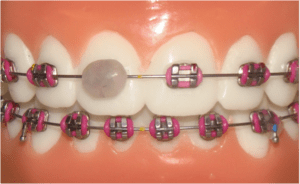
Loose Wire
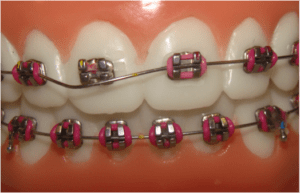
Use a tweezer and try to put the wire back into place, then place wax over the bracket and wire to stabilize.
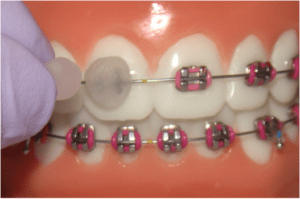
If you cannot put the wire into a comfortable position and wax does not help, use a small fingernail clipper to clip the wire behind the last tooth to which it is securely fastened. Place wax on the end of the wire if it is causing discomfort.
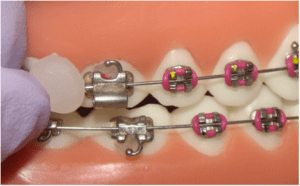
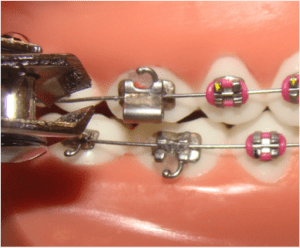
Poking wire
Use a pencil to push the wire into position so that it is no longer causing discomfort.
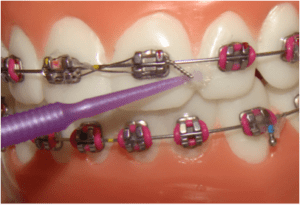
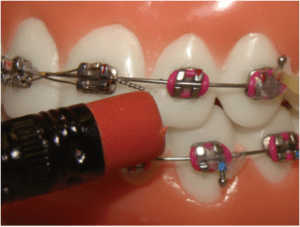
It is important to maintain good oral hygiene throughout the length of your orthodontic treatment. Braces, wires and bands can trap food particles making it difficult to brush and floss away plaque. Careful brushing and flossing is the best way to prevent plaque build-up, tooth decay and gum disease.
Our orthodontists recommend brushing with a soft bristled toothbrush and fluoride toothpaste after mealtimes or at least 3 times per day for a minimum of 2 minutes. A gentle thorough circular motion both at the gum line and under wires will help remove food particles and plaque.
Flossing is necessary to clean the areas between teeth that a toothbrush cannot reach. We recommend the use of floss threaders for ease of flossing teeth while in braces. We also recommend using a fluoride rinse such as Phosflur or ACT on a daily basis.
Initial photo series taken prior to orthodontic treatment.


Patient 1: After
Final photo series taken after a 30 month case which included a Trans Palatal Arch appliance, full upper and lower braces and elastics.


Patient 2: Before
Initial photo series taken prior to orthodontic treatment.


Patient 2: After
Final photo series taken after two phases of treatment. The first phase included a removable K-D appliance for 5 months. The second phase included full upper and lower braces for 17 months.


Patient 3: Before
Initial photo series taken prior to orthodontic treatment.


Patient 3: After
Final photo series taken after a 25 month case which included extractions, full upper and lower braces and elastics.


Patient 4: Before
Initial photo series taken prior to orthodontic treatment.


Patient 4: After
Final photo series taken after a 26 month case which included extractions, full upper and lower braces and elastics.


